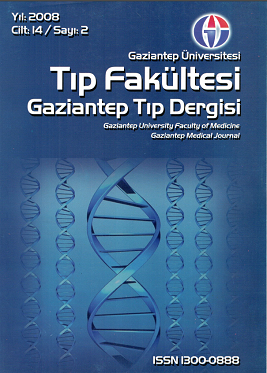The Relation Of Left Or Right Visual Acuity And Psychologic Symptoms In Strabismic Patients
DOI:
https://doi.org/10.58600/eurjther.2008-14-2-1336-archKeywords:
Strabismus, Visual acuity, Eye preference, Psychological symptomsAbstract
Strabismus refers to any abnormality of eye coordination or alignment that results in loss of binocular vision. The rate of right-eye preference was reported to be greater at the right-handed subjects than the left-handed ones. The eye has a visual acuity threshold below which an object will go undetected. The 39 consecutive subjects, who had esotropia or exotropia, were enrolled in this study. We noticed a relation in most of the parameters between intensity of psychological symptoms and visual acuity of the right eye, whereas there was no such relation with the lefte eye. Another interesting finding was the validity of this relation for only men. We may propose that differences in cerebral complex network concerning lateralization may be responsible for this relation of the parameters between intensity of psychological symptoms and visual acuity of the right eye.
Metrics
References
Money, J. Studies on the function of sighting dominance. 1972;24:454-64.
Porac C, Coren, S. Lateral preferences and human behavior. New York, Springer Verlag, 1981.
Bourassa DC, McManus IC, Bryden, M.P. Handedness and eye-dominance: a meta-analysis of their relationship. Laterality. 1996;1:5-34.
Dellatolas G, De Agostini M, Curt F, Kremin H, Letierce A, Maccario J. et al Manual skill, hand skill asymmetry, and cognitive performances in young children. Laterality. 2003;8:317-38.
Annett, M., Left, right, hand, and brain: right-shift theory. Hillsdale, NJ: Erlbaum, 1985.
Annett, M., Turner, A. Laterality and the growth of intellectual abilities. British Journal of Educational Psychology, 1974;44:37-46.
Baykal, O., Dane, S., Akar, S., Colak, A., Pence, S. Relationships between hand preference and eye dominance in normal human subjects. Turkish Journal of Medical Sciences, 1995;24: 95-97.
Dane, S., Gumustekin, K. Correlation between hand preference and distance of focusing points of two eyes in the horizontal plane. International Journal of Neuroscience, 2002;112:1041-1047.
Merrell, D. J. Dominance of eye and hand. Human Biology, 1957;29:314-328.
Dolcos, F., Rice, H.J., & Cabeza, R. Hemispheric asymmetry and aging: right hemisphere decline or asymmetry reduction. Neuroscience and biobehavioral reviews, 2002;26:819-825.
Geshwind, N., Behan, P. Left-handedness: Association with immune disease, migraine, and developmental learning disorder. Proceedings of the National Academy of Sciences. 1982;79:5097-5100.
Springer, S. P., Deutsch, G. Left brain, right brain: Perspectives from cognitive neuroscience. New York: Freeman. 1998.
Gur, R. C., Turetsky, B. I., Matsui, M., Yan, M., Bilker, W., Hughett, P., & Gur, R. E. Sex differences in brain gray and white matter in healthy young adults: Correlations with cognitive performance. Journal of Neuroscience. 1999;19:4065-4072.
Tan, Ü. The left brain determines the degree of left- handedness. International Journal of Neuroscience. 1990;53:75-85.
Tan, Ü., Kutlu, N. Right and left hand skill in relation to cerebral lateralization in right-handed male and female subjects: The prominent role of the right brain in right-handedness. International Journal of Neuroscience. 1992;64:125-138.
Kamis, U., Gunduz, K., Okudan, N., Gokbel, H., Bodur, S., Tan, U. Relationship between eye dominance and pattern electroretinograms in normal human subjects. International Journal of Neuroscience. 2005;115:185-92.
Geschwind, D. H., & Miller, B. L. Molecular approaches to cerebral laterality: Development and neurodegeneration. American Journal of Medical Genetics, 2001;101:370-381.
Davidson, R. J., Hugdahl, K. Brain asymmetry. Cambridge, MA: MIT Press. 1995.
Effect of skill on visual laterality: now you see it--now you don't. Brain Cognition, 1994;24:277-83.
Ricci, F., Cedrone, C., Cerulli L. Standardized measurement of visual acuity, Ophthalmic Epidemiology. 1998;5:41-53
Porth, C. M., Kunert, M. P. Pathophysiology concepts of altered health states Lippincott Williams and Wilkins, Philadelphia, 2002.
Lavrich, J. B., Nelson, L. B. Diagnosis and management of strabismus disorders. Pediatric Clinics of North America, 1993;40:737-751.
Derogatis, L.R., Lipman, R.S., & Covi, L. SCL-90: an outpatient psychiatric rating scale--preliminary report. Psychopharmacolgy Bulletin. 1973;9:13-28.
France, A.I., Alpher, V.S. Structural analysis of social behavior and perceptions of caregiving. Journal of Psychology, 1995;129:375-388.
Derogatis, L. R. Confirmation of the dimensional structure of the SCL-90: A study in construct validation. Journal of clinical psychology, 1977;33:981-989.
Dağ. I. Belirti tarama listesi (SCL-90-R) 'nin üniversite öğrencileri için güvenirliği ve geçerliliği. Türk Psikiyatri Dergisi, 1991;2:5-11.
Annett, M., & Kilshaw D. Mathematical ability and lateral asymmetry. 1982;18:547-68.
Downloads
Published
How to Cite
Issue
Section
License
Copyright (c) 2023 European Journal of Therapeutics

This work is licensed under a Creative Commons Attribution-NonCommercial 4.0 International License.
The content of this journal is licensed under a Creative Commons Attribution-NonCommercial 4.0 International License.


















